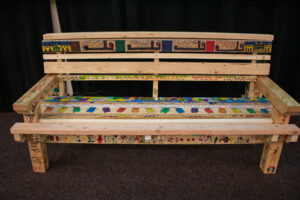 This article originally appeared in the Spring 2024 print newsletter.
This article originally appeared in the Spring 2024 print newsletter.
This year, Pikes Peak Habitat for Humanity’s interfaith partners came together to create a unique bench for Jessica, our 3rd Interfaith Build for Unity (IBU) homeowner, and her son, Bryson. Participating faith communities decorated boards with blessings, Scriptures, and images. Guests at the interfaith dialogue in early February also had the chance to contribute their thoughts and prayers. The completed bench was presented to Jessica and Bryson at their home dedication Feb. 24.
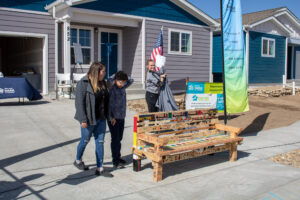 “The bench serves as a physical representation of the beauty that can be created when different faith groups come together,” explains Chloe Henry, Pikes Peak Habitat Faith in Action program manager.
“The bench serves as a physical representation of the beauty that can be created when different faith groups come together,” explains Chloe Henry, Pikes Peak Habitat Faith in Action program manager.
Jeff Mawhirter of Christ City Church said the bench idea arose from the IBU subcommittee’s desire to create “a more visible version of the stud signing. This is where different faith groups sign the studs inside the walls of the home with spiritual passages, words of encouragement, etc.,” he explains. “During a previous partnership build, we did a similar bench, and it seemed like a great way to fulfill that desire.”
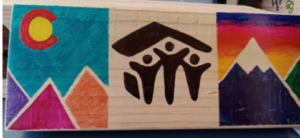 Representatives brought boards to their faith communities, who spent several weeks decorating them. Then Mawhirter and other IBU subcommittee members put the pieces together, creating the completed bench. “It’s the joining of the messages and artwork that are the real value,” he says.
Representatives brought boards to their faith communities, who spent several weeks decorating them. Then Mawhirter and other IBU subcommittee members put the pieces together, creating the completed bench. “It’s the joining of the messages and artwork that are the real value,” he says.

“The best projects are the ones in which people work together, and this one did exactly that!” says Barb Treacy from St. Francis of Assisi Parish. “In a world that seems more divided than ever, Pikes Peak Habitat continues to bring people together, reminding us that we have more in common than the nightly news wants us to believe!”
Jeff Ader, chair of Pikes Peak Habitat’s IBU subcommittee and president of Temple Beit Torah, agrees. “Temple Beit Torah was inspired to participate in the Unity Bench project due to our fundamental belief that all belief systems share more commonalities than differences,” he explains. “We saw the build and the bench as a tangible expression of this shared humanity and unity among diverse faith communities.”
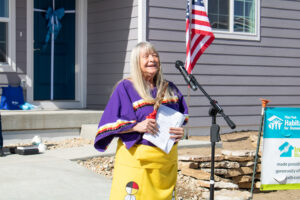
The bench features contributions from Christian (both Protestant and Roman Catholic), Islamic, Jewish, and Native American groups. Although their beliefs differ in some respects, they’re united in their well wishes to Jessica and her son as they begin life in their new home.
“We just hope she LOVES her new home and has a chance to relax on this bench to just enjoy the view and life a bit,” says Kymm Hockman from First United Methodist Church Prairie Campus. “We hope the bench blesses her and her family.”
Tamer SayedAhmed, chaplain at the U.S. Air Force Academy, worked with the USAFA Muslim Cadets on the project, and he says they chose passages that reflect their hopes for Jessica and Bryson.
“We believe the last three chapters of the Quran (112, 113, and 114) help seek God’s protection against envy and evils,” he says. “As a result, we wrote those chapters of the Quran to ask God to protect Jessica’s new home.”
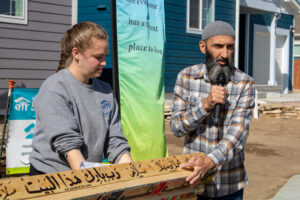
Feda Jodeh and Kamel Elwazeir from the Islamic Society of Colorado Springs contributed a board with blessings, including “Peace,” “May God bless this home,” and “Love,” burned into the wood. “These words have great significance,” explains Jodeh. “They are used across many faiths and offer a reminder to the homeowner that they are finally in a permanent home, where they have safety, security, love, and peace.”
Jessica notes that the IBU is “great because we are all coming together, and in this instance, everything is put aside—even though we are learning from one another.” Adding to the learning aspect, many designs expressed values and symbols that are important to the faith traditions and communities that decorated the boards. The Native American Women’s Association contributed a post with a traditional design featuring black, red, white and yellow, often used to symbolize the four directions, four seasons, sacred path of the sun, and human beings. Temple Beit Torah’s “designs predominantly featured the Star of David, a symbol deeply significant in the Jewish faith,” says Ader. “The Hebrew word ‘Chai,’ meaning ‘Life,’ was prominent, reflecting the core values and aspirations of our tradition. The inclusion of a Jewish prayer for family underscored the importance of community and connection within our faith tradition.”
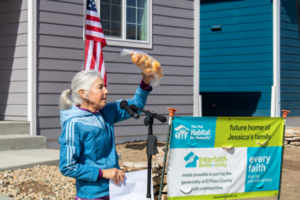
Both Temple Shalom and Christ the King Lutheran Church drew inspiration from the stained-glass windows in their places of worship. And First United Methodist Prairie Campus contributed designs with their own congregational symbols and motto. “Our sort of ‘symbol of inclusion’ is a set of cute, colorful gummy bears,” says Hockman. “So the one board is covered with colorful gummy bears. Our church ‘swag’ says ‘Love Each Other’….so the other board bears that phrase in many different colors and handwritings.”
The boards were truly an intergenerational effort, with designs contributed by everyone from adult groups, such as the Knights of Columbus at St. Francis of Assisi Parish, to children. “They were very excited to be a part of this project,” says Treacy of the latter. “Some of them are too young to write messages, and because it was done around Christmastime, you may notice a Santa or Christmas tree!”
Those who decorated the boards also benefited. “Members of our church have enjoyed working alongside people from other faith traditions to help a neighbor in need of affordable housing,” says Stephanie Sparks from Grace & St. Stephens Episcopal Church. “The concept of the bench being a visual representation of our involvement in this project was well-received.”
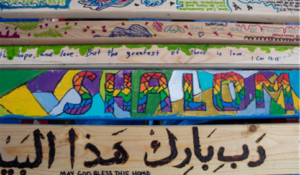 And the project provides a valuable reminder: “It is possible to bring people together to create a gift that reflects the unity and cohesiveness of the relationships we have built that span across various faiths,” says Jodeh.
And the project provides a valuable reminder: “It is possible to bring people together to create a gift that reflects the unity and cohesiveness of the relationships we have built that span across various faiths,” says Jodeh.
Mawhirter agrees. “I think about the unity it represents at moments when I start feeling that unity is missing in the world,” he says. “Peace and unity isn’t missing, it’s right here, and we are blessed to be living in it.”
Stay tuned to the blog for more comments from the IBU subcommittee members involved in this project!

